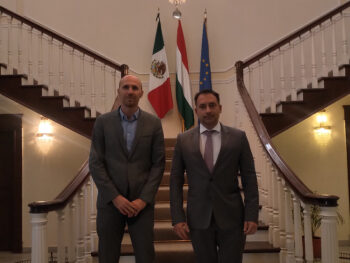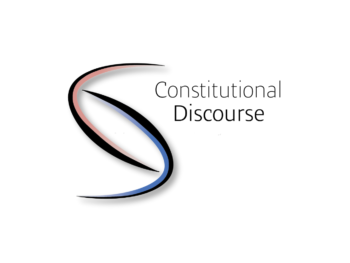The invisible constitution is actually ‘invisible power’. Ever since the constitution is an immanent part of the legal system, the Constitution is law. It is a ‘power tool’, an instrument of power. The essence of power is the domination of will: the power can force its will on others, and those who exercise power on others. There are branches of power in order not to concentrate too much and too great a power in the hands of one man (say an otherwise enlightened but absolutist ruler). There is a legislator (legislative), an executive (government) and a law enforcement (judicial) power. The first step in the application of the law is to find the legal elements corresponding with the relevant elements an interpersonal relationship and to reconcile and match them with each other (subsumption, subsumptio). Next up, the interpretation and the unveiling of the content of the chosen and applicable law, which, in essence, is nothing else but the exploration and interpretation of the legislator’s will and purpose, i.e. the decision of power. Thus, the interpretation itself is power. If the Constitution is at the top of the legal system and the Constitutional Court sits at the apex of the interpretative forums, then the Constitutional Court itself is the supreme authority. The actual will of power will be what the Constitutional Court will say as the last word. Supreme power is held by the one with last word, the holder of “final interpretation”. In a democracy, however, all power and supreme power belong to the people. However, this is rarely practiced directly (by popular vote). In representative democracy, this is the main authority of the People’s Representatives (National Assembly, Parliament). The supreme power of “final interpretation” of the Constitution is that of the constitution-making power (authentic, legislative, interpretation by the ‘pouvoir constituant’). This is rarely exercised by the constitution-making power. For the Constitutional Court, on the other hand, it is a continuous, constitutional duty and obligation. The Constitutional Court is not an “one-man” institution, but a body, making its decisions by a majority of votes. The greater the majority, the more convincing its decision is, and vice versa. The composition of the body and the value-system of the majority of its members also matters.
The invisible constitution is actually visible law: the mandatory norms of international law (UN Universal Declaration of Human Rights 1948, the International Covenants of Civil and Political Rights and Economic, Social and Cultural Rights 1966/1976 and other human rights conventions), the Rome Convention (1950, together with the ECtHR’s practice) plus the EU’s “constitution” (Lisbon Treaty, Charter of Fundamental Rights, CJEU case-law, etc.).
These are new layers of law over the national legal system and the national constitution. The more layers of law, the more difficult, complex and contradictory the application of the law is, the more levels the forum system for the application of the law is, and the more difficult it is to ensure the uniformity of law. In this increasingly complex legal system, it is necessary to find the right forum and the applicable law, and then, by interpreting it, to explore its correct content, and finally to make an erga omnes, final decision. The law revealed, interpreted and applied in such a decision will become visible and traceable as living law, a living instrument.
According to Károly Szladits (a central, historical figure of Hungarian private law tradition), this measurement correlated to the highest level of legal and fundamental principles and framework-norms is “evaluative interpretation”: exploring the meaning of an ambiguous legal provisions by using “measures of correctness”. These measures of correctness of the interpretation are given by the basic ideals of the law. They must be based on the assumption that law seeks fair results with meaningful objectives. External indicators and value-ideals should also be taken into account, such as: A) The current perception of values in the leading social strata; B) The latest achievements of modern jurisprudence; C) the values of intelligent ordinary people; D) The concept of professional circles and professions; E) Patterns in usage and customs; F) The general cultural ideals of humanity; etc. The interpretation of the law thus defined is considered to be the correct, objective interpretation (Szladits Ed. Volume I, Hungarian Private Law, 1941 pp. 156-158.).
The most recent (20th, 21st century) general (universal) cultural ideals of humankind are fundamental freedoms and human rights (their 1st, 2nd, 3rd generation, etc.). These ideals (which can also be called an ‘invisible constitution’) should be implemented today and in the future by means of national constitutions and legal systems. The distance and difficulty of approaching reality and ideal (the ‘sein’ and ‘sollen’) has been known since Aristotle, and this distance and difficulty varies from age to age and state to state, but is always a given. An ideal is ideal exactly because it is always necessary to strive for it, although we know that it is never attainable. Even if reality approaches it, the ideal transcends to a higher level. Therefore, measured against the general cultural ideals of humanity – transcribed into law: against legal concepts – reality will always be unlawful, illegal. If the State is the one obliged against the holders of human rights entitled to claim compensation for the violations of their rights, the State may be liable for misconduct at any time, and may be liable for damages on an objective basis (regardless of attributability and exculpation). Even if, for material or cultural reasons, it would be incapable of enforcing human rights to a higher, “almost ideal” level, would it be capable of mass compensation? If so, then it’s probably worth setting up a “litigation business”. It would be good to resolve this paradox in order to protect rich countries and the poor African, Asian, Central and South American states (and human rights).
Why was the concept of ‘invisible constitution’ and ‘strong’ Constitutional Court necessary during the period of regime change in Hungary? Because of two assumptions: one is that in the first free elections, the parliamentary majority and government power will be acquired by the MSZP; the second is that the former party nomenclature will also give the first President of the Republic. None of the assumptions turned out to be true, but the strong Constitutional Court (the strongest in Europe) remained. “the judge of the legislature”, annulment of laws, the possibility of actio popularis, etc.).
The Hungarian Constitutional Court exerted a great influence not only on the development of the legal system, but also on the constitutional value system, and through these indirectly on the political, economic, social, cultural, etc. subsystems, and the whole process of transition. The real dividing line here was 2010, the two-thirds parliamentary majority and, along with it, the acquisition of constitution-making power by one political force. The reason for this is twofold: the mass negative feeling of “we did not want such a change of regime” (which also cast a shadow on the Constitutional Court); and the global financial and economic crisis of 2006-2009, including Hungary’s renewed indebtedness by the old political forces appearing in the robes of ‘new power’ and the threat of bankruptcy, which would have had a mass of private insolvencies and unforeseen political consequences. The ideal that all power in a democracy belonged to the people became a living instrument, and the electorate’s will rearranged the system of political power (“second regime change”), which also rearranged the preexisting rule-of-law system of division of powers. Life itself, new circumstances, and the new political environment have changed the “supreme authority of interpretation” of the Constitutional Court and the self-perception of its role. The Parliament (as a pouvoir constituant, i.e. constitution-making power) has taken back the major interpretive-evolutive power from the Constitutional Court, along with the adjacent supreme political responsibility.
The Constitutional Court must continue to protect and preserve – not only the text of the norm in textualist manner, but also its value content. The Fundamental Law is the “introductory provision” of the whole legal system, the source of all branches and fields of law, a systematic collection of the broadest framework norms, legal principles, fundamental principles and values. The legislative, executive, and judicial branches of power operate within this framework. This is what the Constitutional Court oversees, also staying within the framework. The main issue of this is the vertical and/or horizontal application of constitutional fundamental rights, their direct or indirect enforcement (which was also a major debate in the process of codification of the new Civil Code and has not yet come to a conclusion). The basic concepts of dogmatic and legal relations need to be rethought: e.g. the concept, ratio and relationship of imperative, cogent and dispositive norms; the ‘overlapping’ and divergence of constitutional fundamental rights and simple legal rights; the possibility of enforcing claims under international “ius cogens” norms or these norms themselves, or the nature of the moral obligations imposed on states, etc.
With the interpretation of the historical constitution and constitutional identity, the Hungarian Constitutional Court does not extend beyond its rule-of-law function, received from the constitution-making power. The interpretation of these concepts requires not activism and newer invisible constitutions but culture beyond the law, thinking in a broad context (historical, economic, financial, social, environmental, comparative law, sometimes natural sciences and their complex application). This requires intellectual effort and courage (fortitude), but also the virtue of moderation (temperance). The Constitutional Court is also barred from abuse, arrogance and rivalry of power. That is what Béni Grosschmid (another emblematic figure of Hungarian civil law at the turn of the century) also thought, who said that “being a lawyer is not a matter of profession but of education!”
If the European Union falls apart, the European identity (as European civilisation) will perish with it, and Hungarian national identity will also share the same fate. Both must therefore be saved (at the same time, together!). At present, instead of forcing the United States of Europe, we need to work towards a community of solidarity formed of strong nation states. The European Union is an alliance of freedom, justice and solidarity, where the Member States have solidarity with each other and with the global world. According to János Zlinszky (professor of Roman Law and a former Constitutional Court judge), solidarity is the legal denomination and institutionalisation of Christian love for neighbours. According to Pope St. John Paul II, Europe is the civilisation of love. That is why Europe is so attractive in the global world, and that is why the soul of Europe must be saved, as Robert Schuman, the father of Europe stated.
The system of barriers and balances (i.e. checks and balances) that is still being refined forms an integral part of the rule of law. This can be projected and even applied to the European Union as a whole as well. The German Federal Constitutional Court (and thus any other national constitutional court) is therefore a barrier and (counter)balance to the EU’s Luxembourg Court and to other versions of unification. It is therefore necessary that EU and national institutions seek balance not the opposition and rivalry of power. The ECtHR and the CJEU can also learn from the German Constitutional Court, and perhaps even from the Hungarian Constitutional Court (see. “Red Star” decision, the decision on registered civil unions).
As long as the CJEU and the ECtHR consider themselves supreme powers of interpretation, they want to dictate. Instead, they should be cooperating partners. Then there would be no such scandalous decisions entailing widespread opposition as the so-called “Kruzifix” decision (Lautsi and Others v Italy, 2011). This resulted in a distorted version of the rule of law, the accusation of “judicial domination” (Richtermacht), and, in the broader sense, the scientific horror of the “juristocracy” replacing the democratic rule of law.
Following patterns and mechanical “code copying” should be replaced by consensus-seeking cooperation between equal and heterarchic professional partners. The objective is common: social peace on a nation-state, European and global scale. It is only in peaceful conditions that there is a chance to resolve other, more serious problems (climate disaster, global social divide, migration), and to address emergencies that are even more serious than the pandemic.
Barnabás Lenkovics
The post was originally published by Barnabás Lenkovics on Constitutional Discourse:











 Newsletter from the president of the Hungarian Lawyers Association – March 2021
Newsletter from the president of the Hungarian Lawyers Association – March 2021